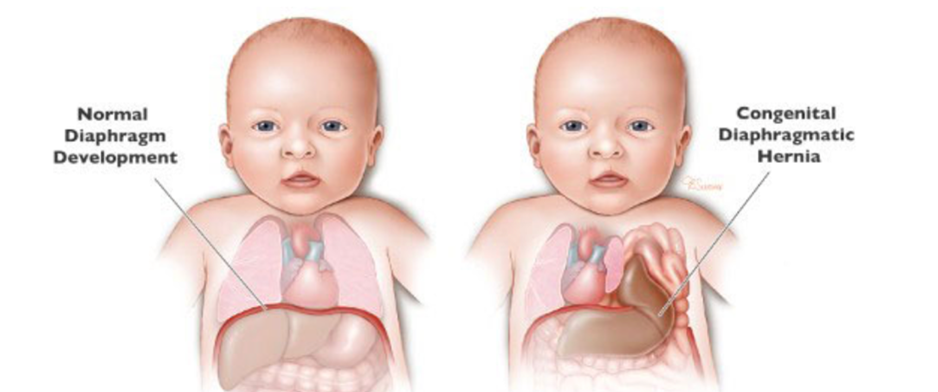Types of Congenital Diaphragmatic Hernia
There are two types of congenital diaphragmatic hernia (CDH), Bochdalek and Morgagni. In both, organs like the stomach, liver, spleen, or intestines may move into the chest cavity causing developmental disruptions. The differences between types of CDH are the location of the hole and the cause of the hernia.- Bochdalek hernia. A Bochdalek hernia is a hole in the diaphragm that can occur on the right or left side. It is caused by either a malformation of the diaphragm or the intestines’ movement into the chest cavity as the diaphragm forms. Left-sided Bochdalek hernias are most common, accounting for ~80% of cases. Bochdalek hernias that occur on the right side are far less common (~10% of cases), but can lead to worse outcomes due to the liver’s movement into the diaphragm.
- Morgagni hernia. A Morgagni hernia is a hole in the middle of the diaphragm near the chest. It happens when the tendon in the middle of the diaphragm develops abnormally. Morgagni hernias are much less common than all Bochdalek hernias.

What are the causes of a Congenital Diaphragmatic Hernia?
There is no known cause for the development of congenital diaphragmatic hernias. There is nothing someone can do to cause or prevent their baby from developing a congenital diaphragmatic hernia.How is a Congenital Diaphragmatic Hernia diagnosed?
Diaphragmatic hernia can be diagnosed using fetal ultrasound in the second and third trimesters of pregnancy, at the 20-week ultrasound, and is often first detected on a routine pre-natal ultrasound. A fetal echocardiogram (ultrasound of the heart) may be done to check for heart abnormalities before birth. Learn more about diagnosing CDH.Treatment for Congenital Diaphragmatic Hernia
Babies with a congenital diaphragmatic hernia (CDH) can have different treatment plans depending on the severity of the case. Most times, a baby is diagnosed with CDH in utero, and during the pregnancy, a treatment plan is developed prior to giving birth.
In addition to CDH surgical repair, postnatal treatment options can include a ventilator, the NICU and/or ECMO (a heart and lung bypass machine that can be used to rest a failing heart or lung). Your baby might not need all these treatments, but it’s vital that they have immediate access to them if necessary. That is why it’s important you deliver your baby in a hospital that can provide this type of postnatal care.
At CHOC, we take a multidisciplinary approach to CDH treatment that provides you and your baby with the best possible care. Our dedicated and highly individualized clinical programs for congenital diaphragmatic hernias have led to exceptional outcomes in patient treatment, with an 88% survival rate for CDH cases (exceeding national benchmarks of 60-70%). As a national leader in pediatric healthcare services, treatment at CHOC also provides continuity in care long after CDH repair to ensure the continued health of your child. Learn more about CDH Care at CHOC.
Symptoms of a Congenital Diaphragmatic Hernia
When CDH is not diagnosed prenatally, the symptoms of a congenital diaphragmatic hernia are observable soon after birth. While they vary between each child, the most common symptoms of CDH include:- Breathing trouble
- Rapid breathing (hyperventilating)
- Rapid heart rate (tachycardia)
- Blue skin color (cyanosis)
- One side of the chest is larger (Abnormal Chest Development)
- Belly looks caved-in (concave/scaphoid)
Developmental Complications from CDH
A congenital diaphragmatic hernia can hinder the proper development of the lungs and digestive system. The lungs, digestive system, and diaphragm all grow in utero at the same time. When a CDH allows abdominal organs to move into the chest cavity during development, the space becomes crowded and causes the lungs to stop growing or grow incorrectly. This underdevelopment of the lungs is known as pulmonary hypoplasia. When a baby’s lungs do not develop properly, they will have trouble breathing after birth.
The intestines may also not develop properly if they do not receive enough blood while growing. A good blood supply is necessary for intestines to develop correctly, be healthy and function properly.
Every CDH case is different, the severity and complications from a congential diaphragmatic hernia are dependent on the size and location of the hole in the diaphgram. The size of the hole determines how much abdominal organ movement into the chest cavity occurs. The more that is allowed to move into the chest, the less space there is for the lungs to grow and vice versa. The location of the hole also determines what organs can pass up into the chest. When larger organs have the ability to move into the diaphragm the lungs have less space for growth. Learn more about development complications for children with CDH.














